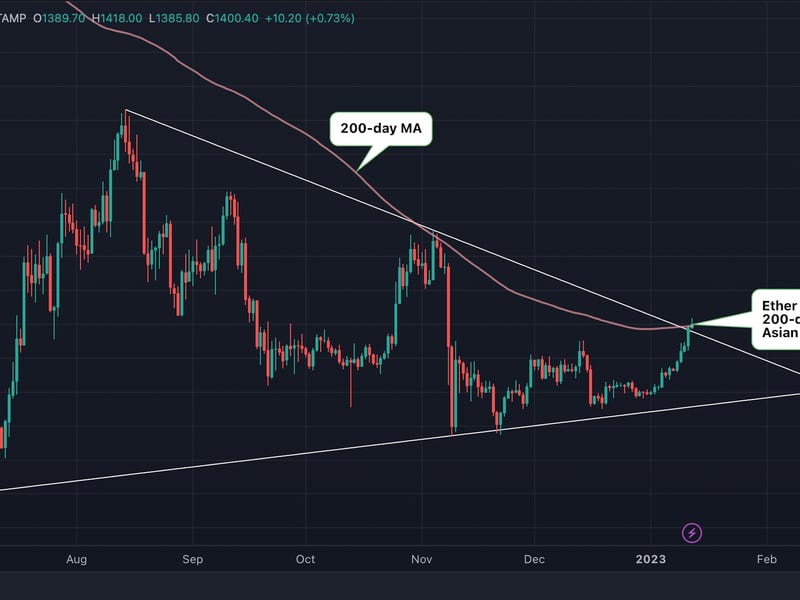Ether Hits Two-Month High Ahead of US CPI; Market Breadth Remains Weak

Ethereum's native token ether (ETH) rallied to a two-month high on Thursday, shrugging off the cautious tone in the U.S. stock futures.
The second-largest cryptocurrency rose nearly 1% to $1,415, the highest since Nov. 8, taking the month-to-date gain to over 17%, CoinDesk data show. Per observers, Ethereum's impending Shanghai upgrade has been driving ether higher. Market leader bitcoin (BTC) topped $18,000, reaching a four-week high.
Whereas, the futures tied to the S&P 500 traded flat-to-negative as investors turned cautious ahead of the U.S. consumer price index (CPI) scheduled for release at 13:30 UTC.
"The macro headwinds are becoming macro tailwinds – the U.S. dollar has peaked and the U.S. inflation is dropping fast. The market has moved on from the negative liquidity impact of the hawkish Federal Reserve and bankruptcy news flow of crypto exchanges and liquidity providers," Markus Thielen, head of strategy and research at crypto services provider Matrixport, said.
"That's why micro is now driving crypto again and why the Shanghai upgrade is lifting prices," Thielen added.
Ethereum's Shanghai upgrade, due in March, will de-risk staking by enabling withdrawals of the ether staked or locked into the Beacon chain since December 2020. The consensus is that the upgrade will boost staking demand, causing a reduction in the circulating supply of ether and markets appear to be pricing that in advance.
"It will motivate many ETH holders to stake their ETH as only 14% of the ETH is being staked now, compared to 58% for other Layer 1 protocols. Hence, another $20 billion of ETH can be easily staked. More ETH staked means less ETH available to sell when negative news hits the market. Hence, this is bullish," Thielen noted.
Noelle Acheson, author of the popular "Crypto Is Macro Now" newsletter, said in the Jan. 9 edition of the market update, "The additional flexibility could entice more users to the network, possibly delivering a net positive gain."
At press time, more than 16 million ETH worth $22.8 billion was locked into Ethereum’s Beacon Chain staking contract, data from Etherscan shows. The tally has increased by 2.6% since Ethereum developers announced the Shanghai upgrade on Dec. 8.

The path of least resistance for ether is on the higher side, the cryptocurrency's breakout from a triangular consolidation pattern suggests.
However, the U.S. CPI could slow the ascent.
"For now, the ether market appears to be in equilibrium near $1,400. If the U.S. CPI comes in softer-than-expected, there is a good chance, the price will continue to rally toward $1,600," Griffin Ardern, volatility trader from crypto asset management firm Blofin, told CoinDesk. "But if it beats estimates, there is a possibility of a pullback."
Consensus is for the Labor Department to show the year-on-year rate of headline CPI gains dropped to 6.6% in December from 7.1% in November. The core figure, which excludes the volatile food and energy component, is forecast to have dropped from 6.0% to 5.7%.
Market breadth remains weak
The total market capitalization of all cryptocurrencies has increased by 12% to nearly $500 billion this month. The bullish revival, however, has been led by a select few coins, including ETH.
That's the message from the market breadth indicator, which measures the number of major cryptocurrencies trading above the 200-day simple moving average (SMA).
The breadth indicator is widely used in traditional markets to assess the degree of participation in a rally and broader market momentum. The market is said to be bullish when the breadth is above 50%. Major coins are ones with at least a $1B market valuation. (smaller coins are prone to manipulation and hence excluded from the study).
At press time, there were 40 cryptocurrencies with a market cap of at least $1 billion.
Of those, 13 – ETH, APE, ATOM, BNB, DOGE, LDO, LTC, MATIC, OKB, QNT, TON, XMR, and XRP – traded above the 200-day SMA, while the rest, including market leader bitcoin, remained in the bearish territory under the key average, according to data sourced from TradingView.
In other words, most major coins traded below the key average, indicating weak breadth or degree of participation in the recent bullish turnaround.








